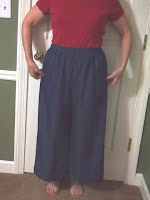 |
| Front view |
Well, it made me wonder. There are opinions and then there are facts. As a former survey-wielding-academic, I decided to do an in-depth study. I ask all the sewers in my studio what they thought of wearable muslins.
And the results are in: it depends.
 |
| Back view |
Take two days ago, for example. TSW urban pants pattern is my favorite pants pattern for comfortable hot-weather wear. It would be fabulous as a skirt. And, heck, I've made it 4 or 5 times now. It's a TNT. So straight away, I cut into this fabulous striped linen - you know, the kind that starts out soft and wears beautifully.
I had to tweak it a little here. Whack. And there. Had to remove the crotch. Whack, whack. Now the stripes are off a little. Whack, whack, whack.
 |
| Humongous. Really. |
I think the problem with making muslins is that we sewers are just a naturally optimistic lot. Why waste all that sewing mojo on ugly muslin when we have the perfect fabric in our stash? Or in the store. Or online.
Luckily my newest pattern from TSW was waiting out in the mailbox - the West End top and pants. No point in fretting over a little mistake with the striped linen. The West End pants are perfect for my upcoming vacation in Texas. The perfect combination of om and yeehaw.
This time, I was more cautious. I cut it out of light weight denim, Louise Cutting's suggested *muslin* fabric, especially since it's going to be wearable. Denim - perfect for Tejas.

And, in the case of TSW, I know my size, right? I've been successfully making patterns from this company for years - size M for tops; size L for bottoms with a few bust-to-hip transitions as needed.
 |
| removing 2-4 inches, easy. |
But I don't look like the model on the front and I don't look the way I visualized myself. Head cocked to the side in my cowboy hat, scuffed Lucchese's peeking out from under the carefully top-stitched hem. No, not at all.
You can see in a couple of these pictures how it would look if I pinched out about 1-2 inches over each hip. Much better.
 |
| Cute pocket though, right? |
I'm thinking back to the last Sewing Workshop pattern I made - the Icon Shirt. It was way too large, and I made my usual size Medium for a top from the TSW. Well, I thought, maybe this is just the style - a big shirt style.
I am also working on the Lotus Skirt, an old Sewing Workshop pattern. It has a fitted yoke, so I did know to make a muslin of the yoke, at the least. And I learned that I need a size 18. Gulp.
So size 18 in the old pattern; size Medium in the new. You decide.
 |
| Top tucked in only to show you. |
 |
| I don't wear tops tucked in. Ever. |
 |
| TNT Urban pants, for comparison |
 |
| Yuck. |




























